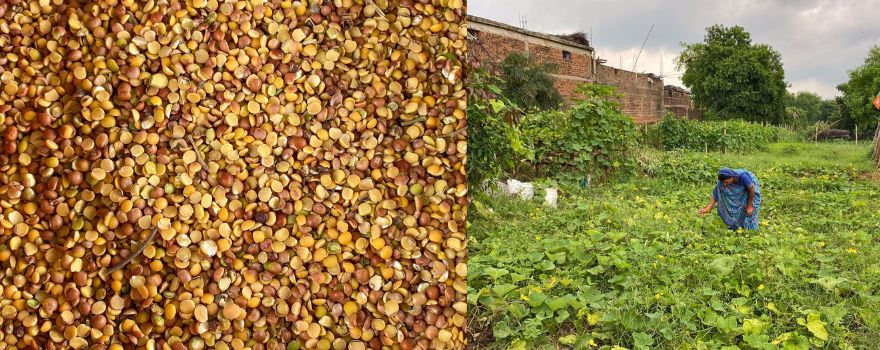How Women Farmers in Panna Are Shaping Their Own Market
11 FEB 2025
In the heart of Madhya Pradesh’s Panna district, a quiet but significant transformation is taking place. A women-led farmers’ cooperative is redefining agricultural trade for Dalit, Adivasi, and OBC women, giving them a firm hold over their earnings from the land. The initiative is not just growing; it is thriving, bringing more women into its fold with each passing day.

Left: Santoshi in her field in Bhairaha panchayat of Panna district Right: The Runj river (after whom the cooperative is named) on whose banks farmers grow arhar daal
Santoshi Kori, a Dalit farmer from Guchara hamlet, is experiencing the sense of ownership for the first time. She recalls how the idea of forming a cooperative took shape among the women in her village. Initially, it was a step into the unknown, but soon, even the men acknowledged the wisdom in their decision. With a membership fee of Rs. 1,000, she became part of the Runj Mahila Farmers Producers Organisation (MFPO) in January 2024, joining 300 other women in Panna district. Today, she sits on the board and speaks at gatherings to encourage others to join.
For years, farmers like Santoshi had no control over how their produce was priced and sold. Traders would buy their arhar dal at lower rates, often delaying payments. Without a local milling unit, they had little choice but to accept these terms. With the formation of the Runj MFPO, this changed. Women farmers pooled their resources, recognizing the value of their organically grown arhar dal and the need for processing equipment. By contributing towards a milling machine, they took the first step towards financial independence.
The dal grown in the Ajaigarh region has a distinctive taste and aroma, known well beyond the district. The fertile lands along the Runj river, which flows from the Vindhyachal hills before merging with the Yamuna, provide ideal conditions for its cultivation. The Dharampur belt, in particular, is known for its high-quality pulses. Pradan, a non-governmental organization working in the region, played a key role in setting up the women’s collective, providing guidance and support to ensure its success.


Left: The dal after it’s split in the machine Right: In her backyard where where she also grows vegetables for self consumption
Now, farmers have a reliable system in place. Instead of dealing with intermediaries, they sell directly to their own collective, ensuring they receive timely payments. Arhar dal prices fluctuate, and in May 2024, the market price dropped from Rs. 10,000 to Rs. 9,400 per quintal. Despite this, the Runj MFPO members felt secure knowing that their produce was being purchased directly at the farm gate, eliminating delays and middlemen.
The cooperative operates with a single employee, CEO Rakesh Rajput, who manages logistics across 12 collection centers. These centers are equipped with weighing machines, bags, and a parkhi to inspect the quality of the produce. The farmers use heirloom seeds, avoiding hybrid varieties, which helps preserve the traditional quality of their dal.
Looking ahead, the cooperative has ambitious plans. Over the next year, it aims to expand its membership five-fold and diversify its product range beyond arhar dal. The women intend to include chickpeas, livestock marketing—focusing on the Bundelkhandi breed of goats—and organic fertilizers and seeds. According to Sugandha Sharma from Pradan, the goal is to create a more connected network, ensuring that farmers can access markets directly without additional hurdles.
Santoshi’s farm is a testament to the effort she puts into her land. In addition to arhar dal, she grows vegetables behind her home, while the family’s buffaloes graze in the fields. She speaks with pride about the dal she cultivates, describing how it cooks as quickly as rice and has a natural sweetness that sets it apart.
The Runj Mahila Farmers Producers Organisation represents more than just an economic shift; it signals a change in the way women in Panna district are shaping their futures. By coming together, they have created a model that empowers them to take charge of their produce, their prices, and their livelihoods. As more women join, their presence in agriculture continues to strengthen, setting an example of self-sufficiency and cooperation that is bound to grow in the years to come.
1734004939.jpg)




















